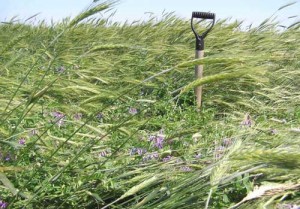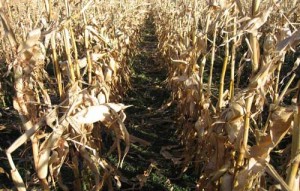Our farming practices differ from conventional methods. Holistic Management has taught us, when we are deliberating an action, to continually ask ourselves the question, “Are we solving a problem or just treating a symptom?” Rather than continually using fertilizers, herbicides, fungicides and other artificial inputs, which are just treating a symptom, we focus on solving problems. This means we start by concentrating on improving the health of the soil.
On our operation we did this by first of all, practicing ZERO-TILL. This was our first step. Next, we looked at what makes healthy native rangeland sustainable. The answer-DIVERSITY! Good healthy native range is tremendously diverse. Often there are over 100 species of grasses, forbs and shrubs in a healthy range. Why then is production agriculture focused on producing monocultures? Where in nature do we see monocultures? So, we diversified our cropping system, warm season and cool season, broadleaves and grasses, fibrous and taproots. In 2013 our cash crops included spring wheat, winter triticale, oats, corn, sunflowers, peas (grain and forage), hairy vetch and alfalfa. Along with these we seeded cover and companion crops of hybrid pearl millet, sorghum/sudangrass, proso millet, buckwheat, sunn hemp, radishes, turnips, pasja, ryegrass, canola, phacelia, cowpeas, soybeans, sugarbeets, red clover, sweetclover, kale, rape, lentils, mung beans and subclover. This diversity provides the food (carbon) that feeds soil life. Soil life, in turn, supplies the nutrients needed for the crops.
The use of cover crops has allowed us to integrate the cropping and livestock enterprises (think holistically). For example, following a winter triticale/hairy vetch crop we will plant a warm season cover crop cocktail of hybrid pearl millet, sorghum/sudangrass, soybeans, cowpeas, sunflowers, sunn hemp, along with radishes and turnips. This mix helps increase the organic matter content of our soils (approximately two-thirds of organic matter increase comes from roots). This cocktail is then grazed anytime between October and January. We have the flexibility to use it when we feel it will best benefit our situation. Our moderately, sized, easy fleshing cattle thrive on it. The cattle are healthier because they are getting plenty of exercise and are not locked in a corral. They are depositing dung and urine on the cropland where it will be consumed by macro and micro-organisms which, in turn will supply the nutrients needed for subsequent crops. We don’t have to haul manure out of corrals and onto the fields. It is a win-win-win situation and it is occurring in a profitable, sustainable way!
We have found the growing of companion crops along with our cash crops to be very beneficial. In 2010 we had fields of corn/hairy vetch and fields of corn/subclover/sweetclover. The companion crops provide a canopy to protect the soil surface, prevent evaporation, feed the corn crop through mycorrhizal activity, increase organic matter and feed livestock after the corn crop is harvested. Another win-win-win situation in a profitable, sustainable way!
Our cropping strategy is ever-evolving and is a continual learning process. We want to thank all of those that have helped us especially, Jay Fuhrer, Dr. Duane Beck, Dr. Kris Nichols, Dr. Rick Haney, Ray Archuletta, David Brandt and Dr. Jill Clapperton. We have tried and failed with many combinations, but that is good as they are a learning experience. We are never afraid of failure. It is simply a learning tool.










